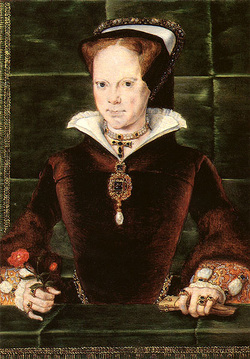Mary I
1516-1558

Mary was born at Greenwich on 18 February 1516, the only surviving child of Henry VIII and Catherine of Aragon. When Henry divorced Catherine to marry Anne Boleyn,her life was radically altered. As Catherine had been married to his dead brother, Arthur,he claimed that the marriage was incestuous and illegal . The pope disagreed, resulting in Henry's break with Rome and the establishment of the Church of England.
Henry's allegations of incest effectively bastardised Mary.Mary was forbidden access to her parents and stripped of her title of princess ,after Anne Boleyn bore Henry another daughter, Elizabeth . Mary never saw her mother again. With Anne Boleyn's fall, there was a chance of reconciliation between father and daughter, but Mary refused to recognise her father as head of the church. She eventually agreed to submit to her father and Mary returned to court and was given a household suitable to her position. She was named as heir to the throne after her younger brother Edward, born in 1537.
Edward VI succeeded his father in 1547 and, under the protectorate of the Duke of Northumberland, zealously promoted Protestantism. Mary, however, remained a devout Catholic. When it became clear that Edward was dying, Northumberland made plans for his daughter-in-law, Lady Jane Grey, to take the throne in Mary's place.
On Edward's death in 1553, Jane was briefly acclaimed queen. But Mary had widespread popular support and within days made a triumphal entry into London. Once queen, she was determined to re-impose Catholicism and marry Philip II of Spain. Neither policy was popular. Philip was Spanish and therefore distrusted, and many in England now had a vested interest in the prosperity of the Protestant church, having received church lands and money after Henry dissolved the monasteries.
In 1554, Mary crushed a rebellion led by Sir Thomas Wyatt. Making the most of her advantage, she married Philip, pressed on with the restoration of Catholicism and revived the laws against heresy. Over the next three years, hundreds of Protestants were burned at the stake. This provoked disillusionment with Mary, deepened by an unsuccessful war against France which led to the loss of Calais, England's last possession in France, in January 1558. Childless, sick and deserted by Philip, Mary died on 17 November 1558. Her hopes for a Catholic England died with her.
Henry's allegations of incest effectively bastardised Mary.Mary was forbidden access to her parents and stripped of her title of princess ,after Anne Boleyn bore Henry another daughter, Elizabeth . Mary never saw her mother again. With Anne Boleyn's fall, there was a chance of reconciliation between father and daughter, but Mary refused to recognise her father as head of the church. She eventually agreed to submit to her father and Mary returned to court and was given a household suitable to her position. She was named as heir to the throne after her younger brother Edward, born in 1537.
Edward VI succeeded his father in 1547 and, under the protectorate of the Duke of Northumberland, zealously promoted Protestantism. Mary, however, remained a devout Catholic. When it became clear that Edward was dying, Northumberland made plans for his daughter-in-law, Lady Jane Grey, to take the throne in Mary's place.
On Edward's death in 1553, Jane was briefly acclaimed queen. But Mary had widespread popular support and within days made a triumphal entry into London. Once queen, she was determined to re-impose Catholicism and marry Philip II of Spain. Neither policy was popular. Philip was Spanish and therefore distrusted, and many in England now had a vested interest in the prosperity of the Protestant church, having received church lands and money after Henry dissolved the monasteries.
In 1554, Mary crushed a rebellion led by Sir Thomas Wyatt. Making the most of her advantage, she married Philip, pressed on with the restoration of Catholicism and revived the laws against heresy. Over the next three years, hundreds of Protestants were burned at the stake. This provoked disillusionment with Mary, deepened by an unsuccessful war against France which led to the loss of Calais, England's last possession in France, in January 1558. Childless, sick and deserted by Philip, Mary died on 17 November 1558. Her hopes for a Catholic England died with her.
